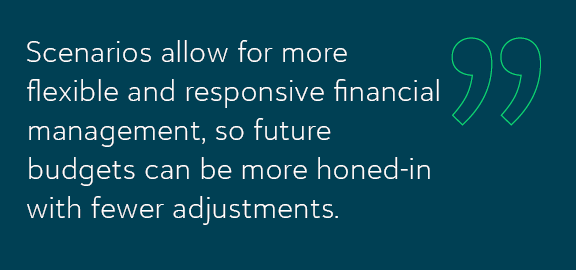Future-Proof Your Organization with Effective Budget Scenarios

Budget scenario planning may not be for everyone. If your programs always bring in their budgeted revenue, if your major donors always come through when they say they will, and if you receive every grant you apply for, you don’t need budget scenarios.
If that doesn’t represent your organization, welcome to the life of the typical nonprofit. And if it does sound like your organization, please share your secrets!
Budget scenarios are essential tools for organizations to navigate financial uncertainties and plan for various outcomes. By creating multiple versions of a budget based on different assumptions, you can better understand potential impacts and make informed decisions.
This approach enhances business planning capabilities and enables more adaptable and responsive financial management. Incorporating budget scenarios into your strategic planning can help your organization stay financially agile and better prepare for potential changes in your funding.
Here is what you need to know about budget scenarios and how to incorporate them into your budget planning.
The Power of Budget Scenarios
Scenario records allow you to create multiple versions of a budget based on different assumptions and variables, such as enrollment in a program or whether a federal grant comes through. You can store all the information you need to track and manage that budget within the scenario.
For example, a nonprofit might create scenarios based on different levels of donor contributions to understand how each scenario impacts their ability to fund programs, or to track various departmental expenses in more individualized ways.
Scenarios help organizations to better understand potential financial impacts and make data-driven decisions that fit seamlessly into a wider-ranging planning process. If you have planned for a dip in grant funding or a wildly successful trivia night, you will already have a roadmap if something similar happens. Scenarios allow for more flexible and responsive financial management, so future budgets can be more honed-in with fewer adjustments.

When to Use Budget Scenarios
You can use budget scenarios to navigate uncertainties and plan for various financial outcomes. Create them prior to budget season, as you are going into your strategic planning process, or as you hear about events that may affect a revenue stream. They are excellent for cash flow planning. For example, community organizations may be at risk of losing or winning a significant grant, or a university might want to plan for potential impact on staffing and resources as a result of funding cuts.
Scenarios also help when considering whether to expand services or launch new programs, helping assess feasibility and assisting with preparation in the event of shortages or delays. They prove essential for such contingencies, enabling organizations to caution against campaigns that might miss their funding targets or adapt more nimbly to regulatory changes.
The flexibility of budget scenarios offers organizations the power to implement long-range strategic planning and ensure sustainability.
Tools to Create Budget Scenarios
There are a couple of tools you can use to create and effectively manage budget scenarios. Many organizations start with spreadsheets, especially for simple scenarios such as whether your signature event will bring in $5,000 or $25,000 in revenue.
For more in-depth scenarios, many fund accounting systems provide budget scenario tools directly within the system. Blackbaud Financial Edge NXT®, for example, has the Budget Creator Excel Add-In that allows users to enter and edit bulk budget data in Microsoft Excel and then import it directly into their fund accounting software. This feature saves time, reduces errors, and allows for complex calculations while working with large datasets. Users who don’t log into the software, like a school’s department heads, can still contribute to the scenario process by working in the familiar Excel environment.
Dedicated budget management options let users develop, copy, forecast, and monitor multiple budget scenarios. You can create an unlimited number of scenarios to facilitate a variety of comparisons across an organization. These can be easily configured to apply to individual fiscal years or cover specific period ranges when fiscal years may overlap. Such flexibility comes in handy, for example, when budgets may need to match the fiscal year of a grantor, or if campaigns have more fluid timelines.
Effective budgeting tools also allow for simplified sharing and collaboration. A private school might need administrators to easily share budget scenarios with board members and stakeholders, or department heads may require CFO approval before a budget is passed to the wider Board. The ability to export budget grids, include budget variables in financial statements, and document changes in detail ensures maximum transparency and cooperation throughout the organization.
As situations evolve, you can track changes to finalized budget scenarios via adjustments directly to the scenario grid itself. Having a centralized system of entry, sharing, and adjustment enhances financial management so challenges can be met head-on.
Simplify Budgeting and Forecasting with Blackbaud Financial Edge NXT®
By using budget scenarios, nonprofits can make informed decisions, mitigate risks, and strategically plan for various financial situations. This proactive approach helps organizations remain resilient and focused on their mission while keeping information all in one place.
With a complete suite of budgeting tools available in a solution like Financial Edge NXT, nonprofits can enhance transparency, streamline financial processes, and ensure compliance, making it easier to adapt to changing circumstances and continue serving their communities effectively.
Want to learn more about how Financial Edge NXT can simplify budgeting for your organization? Check out our on-demand webinar, 10 Ways Financial Edge NXT Makes Budgeting Easier.
Already a Blackbaud customer? Check out the latest courses to learn how to get the most from all the tools at your disposal.
Free White Paper
Future-Proofing Your Organization’s Finances: Proactive Steps to Ensure Stability and Growth



